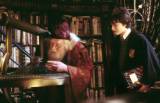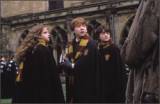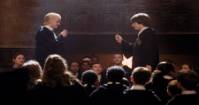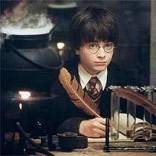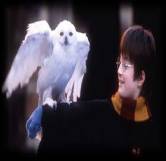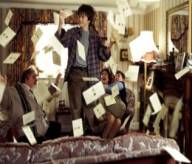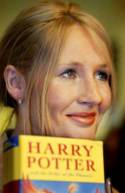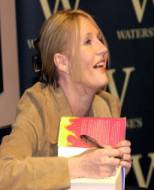 打印本文
打印本文  关闭窗口
关闭窗口 教案示例
第二课时
I. Teaching aims:
1.talk about art and literature.
2.Similar dialogue presentation with new words and expressions used within
II. Teaching aids: tape recorder, pictures, video, slide show
III. Grammar: The Restrictive and Non- Restrictive Attributive Clause
IV. Teaching steps:
1. Pre-reading:
1.T show some pictures (if possible teacher can show video about Harry Potter)
and ask:
do you like Harry Potter?
Have you read any of the Harry Potter books or watched the films?
Do you like him? Why?
2. introduce briefly JK.Rowling who write a series of the book s about ‘Harry Potter’
Do you know the writer of ‘Harry Potter’? show the pictures
|
J.K. Rowling Joanne Rowling (born July 31, 1965) is the British author of the internationally famous series of children's fantasy stories concerning the exploits of the boy wizard Harry Potter. She is the richest woman in the United Kingdom. As her publisher, Bloomsbury, wanted to use initials on the cover of the Harry Potter books (suggesting that if they put an obviously female name on the cover, young boys might be reluctant to buy them), Rowling chose to adopt her grandmother's middle name of "Kathleen". |
3. Pair work: let Ss discuss these questions:
Do you have magical powers?
Do you know of any other heroes who have strange powers?
Do you like to watch magic tricks?
Have you ever tried doing a magic trick?
II. Reading
1. skimming: let Ss read the text carefully, and find out the answer to questions.
Who is Harry Potter? (he is a boy with a scar on his forehead and a secret past. He has magical powers.)
What are the books ‘Harry Potter’ about? (the books are about magic and strange creatures, but they still tell us something about the real world)
2. skipping: read the passage carefully and answer the following questions:
why is Harry’s life miserable before he goes to Hogwarts? (Harry’s life before he goes to Hogwarts in miserable because his parents are dead and the family he is living with treats him badly.)
What does Harry learn about himself at Hogwart?.
(At Hogwarts, Harry learns that he needs to be strong/ that he needs friends/ that it is difficult to do the right thing/ that life is more complicated than he thought/ the truth about his past/ about the power of love and goodness)
3. listening: play the tape and let Ss read the passage.
III. discussion
let Ss work in pairs, and discuss the following questions:
Why does Rowling use strange creatures in her books?
Do you think that we can learn about the real world by reading novels?
IV. Exercises
Finish off the exercies2 in page 81
III. Post-reading
1. pairs work: let Ss work in pairs.
Imagine you have magic power. What should you do with supernatural power?
2. pairs work: let Ss work in pairs and discuss what do you think of Harry Potter?
3. pairs work: let Ss work in pairs and discuss Do you know of any other magic books?
What kind of novel/ books do you like? Why?
IV. Language points Much of what happens is strange. A series of books Seem like Make friends In trouble Be afraid of Make….difficult Fight against Share the same goals, hopes and dreams Believe in Live a good life.
V. Exercises Let Ss finish all the exercises in the book.
教案点评:
《教学示例(二)》--根据新教材中的以阅读为主的教学环节(pre-reading; reading; post-reading)所设计的一课时/两课时教案。本课阅读课的目的是指导学生正确家鉴赏世界名画,同时培养学生用英语讨论绘画、电影、戏剧、音乐会、以及小说等内容的能力。
这个教学过程分三个步骤:pre-reading, while-reading, post-reading。
pre-reading:在阅读课文之前,教师可适当的讲解与本单元有关的背景知识或通过提问的方式引入课文主题。教师可根据课文的内容和篇章结构,从不同的角,引导学生对课文内容进行预测和讨论。
阅读
while-reading:课文分三个步骤:掠读,即带着某个问题进行搜索式阅读,这样能培养学生捕捉关键句的能力;略读,即教师指导学生通读全文,理解课文大意,培养学生发现文章或段落的主题句及概括大意的能力;细读,即加深对课文理解。培养学生的分析和逻辑推理的能力,并帮助学生对文中的难句进行句子结构的分析。
post-reading:教师通过作练习,小组讨论,复述课文等等让学生加深对课文的理解。
通过这三个步骤的训练,学生对课文理解得比较深刻,同时也掌握了文中的语言知识。
 打印本文
打印本文  关闭窗口
关闭窗口 